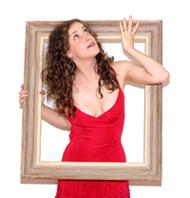 Looking to brighten your home with a little bit of art? Here’s how:
Looking to brighten your home with a little bit of art? Here’s how:
Hang art for viewing from either a sitting or standing position, whichever is done most in the space.
For example in a dining room the art is preferable when hung at eye level from a seated position, lower than that hung in the hallway, where people are viewing it from a standing position.
Place framed art 4″to 9″ or a hand width above a sofa, chair, or table.
Art must relate to it’s surroundings, so keep it near the furniture where it is placed. Don’t hang you art more than a hand width above a piece of furniture unless there is something, like an accessory that is going to be placed on the table below the art.
Cover 2/3’s or 3/4’s of the space over a sofa or table to provide scale with the furniture.
Avoid placing a piece of art that is only 50% of the width of the furniture. If you do not have one piece that will fill the space, place several to create a dynamic grouping!
Create balance, formal or informal in an arrangement.
Just like any form of design, weight and balance are design principles that apply to art arrangement. Try to integrate both forms of balance in every room, adding interest to the space.
In general the greatest weight should be on the bottom and to the left in any design arrangement.
In the West especially we like to see the greatest weight in this way. I have heard it is because we read from left to right, however there is always someone in every group who prefers it the opposite way! For sure, you must consider and include the elements surrounding the art. Weight is not always size but can be influence by the darkness of the piece either in image or framing design.
Arrange art in a grouping close enough so that pieces relate to one another.
Be careful not to place pieces too far apart. Just like the principle of relating art to the furniture, art in a grouping must be close enough so that it says, I need you to the other pieces surrounding it. A good rule of thumb is about 2-4″ apart and in proportion to the size of the art pieces.
Create at least one vertical and one horizontal line to give the eye a point of reference.
Can you draw an invisible line from top to bottom and side to side within the art grouping or along the bottom? If there are no opportunities at all like this, there is a feeling of chaos and unrest. I bet you have experienced this!
Diagonal placement is for stairs, thank you!
Everyone tries the diagonal placement at some point in their decorating life. Keep in mind a simple principle, what goes up must come down, preferably in the same space.
Arrange art groupings in geometric shapes such as rectangular, oval, and triangular.
It’s so much easier to arrange a grouping when you have a general plan based on a shape. It doesn’t need to be and exact shape, just a suggestion is fine. The art in most cases if it is a collection rather than a set, will not allow perfection.
Place mirrors so that they reflect something beautiful.
Mirrors are so useful in interior design. They can expand the space and create wonderful effects as long as they are reflecting something…preferably something worth reflecting, something beautiful!
It’s all part of creating the Fine Art of Wall Design!
Suzanne Gallagher, ASID industry partner and NWSID Professional Resource Affiliate, is the author of “The Fine Art of Wall Design.” Visit her Web site for a few copy of “Hang Your Art, Not Yourself”; www.walldesigndiva.com. All Rights reserved, Copyright 2008, Suzanne Gallagher. Suzanne@walldesigndiva.com; 503.579.2787 (Arts).
